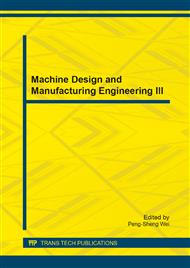p.422
p.427
p.431
p.435
p.440
p.449
p.454
p.458
p.467
Slip Enhancement in Continuously Variable Transmission (CVT) by Using Adaptive Fuzzy Logic and LQR Controller
Abstract:
Enhancement of fuel consumption and transmission efficiency needs a continuous improved variator performance in continuously variable transmission (CVT). This paper focuses on the improvement of a slip controller for a hydraulically actuated metal push-belt continuously variable transmission (CVT), using model for variator dynamic in the CVT. The slip control purpose is to improve the performance of variator and to increase the efficiency of CVT by determination the line pressure which generates the clamping force. The selection of slip reference-point is taken at the transition region between the micro and macro slip region to guarantee the maximum variator efficiency. The adaptive fuzzy logic control (FLC) and Linear Quadratic Regulator (LQR) controllers are applied to control the clamping force. The proposed control systems are designed to ensure the existence of a slip values within the region, which has the traction coefficient maximum value, while the load disturbances caused by suddenly changed torques in the drive lines. These approaches have potential for the CVT efficiency improvement, as compared to PID controller. The adaptive fuzzy logic control technique uses a simple group of membership functions and rules to achieve the desired control requirements of slip in CVT. Simulation results show that satisfactory slip improvement is achieved together with good robustness against suddenly changed torques. It is further revealed that all adaptive fuzzy logic control and LQR controller have a valuable effect on minimizing the slip amount and maximize the variator efficiency
Info:
Periodical:
Pages:
440-448
Citation:
Online since:
July 2014
Authors:
Price:
Сopyright:
© 2014 Trans Tech Publications Ltd. All Rights Reserved
Share:
Citation:


